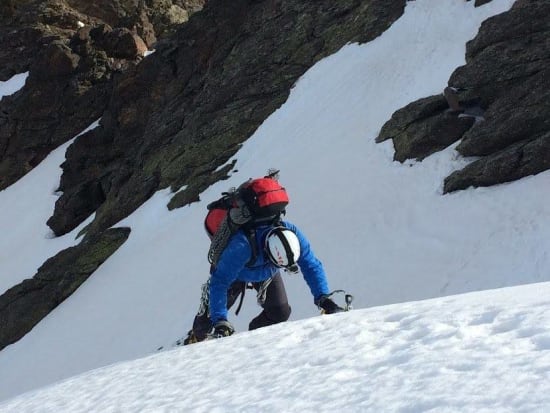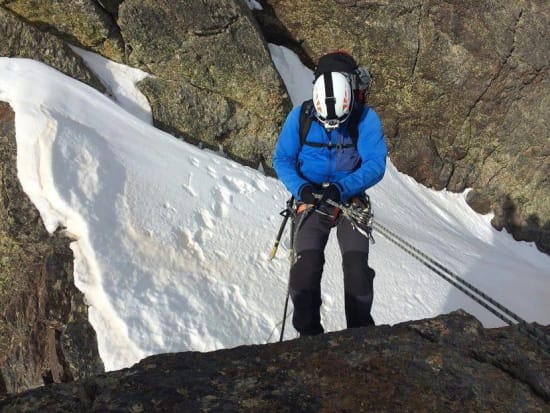A report from Ian Tupman who made his first winter ascent of the NW ridge of the Tozal del Cartujo in Spain's Sierra Nevada in late April 2015 with Spanish Highs guide, Felipe Nieto.

The NW ridge of Tozal de Cartujo seen from the approach
In October 2013 I joined up with Spanish Highs for a 'dry' traverse of the Arista del Cartujo (see earlier report). Having completed it, I wanted to go back and do it in winter conditions but the weather and other commitments conspired to delay my return until now.
I picked up Felipe in Lanjarón and we drove to Hoya de la Mora, arriving at 4.30 in the afternoon. The plan was to walk in to the base of the ridge, bivouac and get an early start in the morning. If we had enough time, we would continue from Tozal del Cartujo, cross to the Elorrieta refuge and traverse the Tajos de la Virgen ridge to Carihuela and then return through the ski area to the car. The weather forecast was for rain to reach the Sierra Nevada around 2.00pm the following day so Plan B would be a descent across to Langunillas and then back to Hoya de la Mora.
Arriving at Lagunillo Misterioso there wasn't a breath of wind. We set up our bivouac, had something to eat and enjoyed the spectacular sunset. However, within half an hour of the sun going down, a southerly wind started blowing. The tarp was well-anchored by snow stakes but it was impossible to sleep with the noise of the wind. At 2.00am there was an almighty bang as a freak gust tore the tarp from most of the stakes. Our immediate reaction was to grab the tarp and as we did so, my sleeping mat was whisked away into the Dilar valley. There followed five hours of discomfort lying on lumpy, frozen snow with the unrelenting noise of the wind preventing any chance of sleep.

Ascending to the ridge
Dawn arrived at 7.00am. The wind was still blowing but it had eased and the sky was clear. We broke camp, put on our crampons and made for a snow-filled gully which would take us onto the ridge. Conditions in the gully varied from bare rock to ice to thigh deep soft snow, making the going difficult and tiring. Upon reaching the rocky ridge some relief was felt as we continued across flatter and snow-free ground. It was apparent that the actual ridge line was almost clear of snow so we decided that to make the ascent more interesting, we would drop down occasionally and make the most of the snow on the west side. This was a good decision and provided some great situations where care and a steady nerve were needed crossing some very exposed slopes.

Steep snows to the ridge
Back on the ridge, the wind made for slow progress at times but we eventually reached the abseil. On our previous ascent the abseil was about twenty meters, this time, with the build-up of snow at its base, it was only around six meters. Reaching the base we stayed on the rope to cross the steep slope to relative safety at the base of the chimney. Felipe led, placing protection as he climbed the snow-filled chimney. The crux of the route is the overhang at the top of the chimney and with a bit of writhing and thrutching, I managed to haul myself up onto the belay stance.

The short abseil into the gap
From this point it was a relatively straightforward walk across the broadening ridge to the summit but the lack of sleep and the physical effort of the ascent were taking their toll on us. It was 11.45am and to the south we could see the approaching weather front. It wasn't a difficult decision to make. We continued east before dropping down to traverse the lower route below Tajos de la Virgen. By now the deep snow was softening but at least we were out of the wind which by then had reached around 60 kmph. We crossed a couple of almost deserted ski pistes before reaching Las Yegüas for a well-earned rest. From there we continued across the ski area, arriving at the car at 3.00pm. Looking behind us the sky was black, the wind had strengthened and we were pleased not to have continued to Tajos de la Virgen.
This was the first time I had done an alpine-style ascent carrying a pack of around 15kgs. That, combined with the snow conditions, wind and lack of sleep, made it a physically and mentally demanding endeavour. For me though, being able to successfully and safely complete a route like this with a good companion is what mountaineering is all about.
